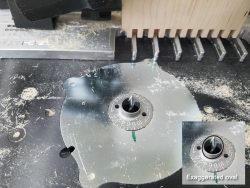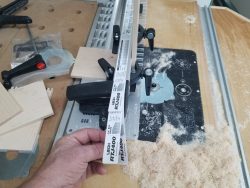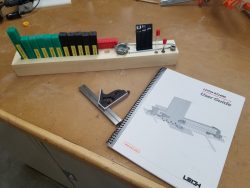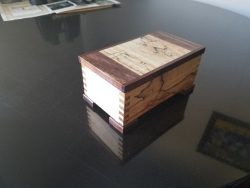As everyone knows, Leigh offers one of the finest dovetail jigs on the market. The Leigh RTJ400 is their newest innovation and uses a lot of the same features their other models include. What makes it different is this jig works upside down!
In comparison, your traditional style jig typically sits on top your bench and you cut your joints by running your a handheld router over the top. With the Leigh RTJ400 you use a router mounted in a table and slide the jig over the top.
I like the router table version for a couple reasons. First and most importantly, when I am doing this task I hate finding a place to sit the router while switching pin and tail boards. Because of this I often sit the router somewhere less than ideal. It’s usually a place where I can trip over the cord or knock it off the bench. And secondly, when using the router table method I can comfortably sit on a shop stool and all I have to do is move boards from the beginning pile to a completed pile.
The RTJ400 handles 16″(400mm) boards and makes 5 sizes of through dovetails at two different pitches, 3 sizes of single pass half-blind dovetails, and 4 sizes of box joints (finger joints).
These include:
- Equally spaced dovetails with approx. 1-1/2″(80mm) pitch
- 5 joint (pin) sizes: 1/4″, 5/16″,3/8″, 7/16″ and 1/2″
- Tails up to 1″(25mm) thick
- Pins up to 13/16″(21mm) thick
- Carcass and box construction
- Equally spaced dovetails with approx. 3/4″(40mm) pitch
- 4 joint (pin) sizes: 1/4″,5/16″, 3/8″and 7/16″
- Tails up to 1″(25mm) thick
- Pins up to 5/8″(16mm) thick
- Carcass and box construction
- Pin and tail boards routed at same time (single pass)
- Equally spaced dovetails with approx. 3/4″(40mm) pitch
- 3 joint sizes: 3/8″, 1/2″, 19/32″
- Joints up to 1″(25mm) thick
- Flush or rabbeted drawer fronts, hidden dovetails, period drawer replication
- Four joint sizes, 3/4″, 3/8″, 3/16″ and 3/32″
- Carcasses, box corners, drawers, tiny jewelry boxes
 Similar to other Leigh jigs the design uses their patented eBush system. The eBush is a guide bushing mounted in this case in your router plate. Note: You need to verify your router plate uses the Porter Cable/Black & Decker industry standard (1 3/8″ diameter) insert ring.
Similar to other Leigh jigs the design uses their patented eBush system. The eBush is a guide bushing mounted in this case in your router plate. Note: You need to verify your router plate uses the Porter Cable/Black & Decker industry standard (1 3/8″ diameter) insert ring.
The eBush is oblong in shape so as you rotate the bushing the clearance changes perpendicularly to the direction you move your jig across the bit. You typically start out in the center position which is #5. You make a test cut on scrap boards and test the joint. If the joint is loose you rotate the eBush to a larger number. If its too tight you rotate it to a smaller number. The only downside to this type of fine adjustment is that you need to make sure you are pulling your jig over the router bit at 90 degrees each time. If you rotate your jig you are doing basically the same thing as rotating the bushing and in the end changing how loose or tight the joint will fit.
 The jig comes with a high quality and easy to follow “shop grade” manual as well as a DVD showing start to finish jointing techniques on all the joints this model is capable of. The jig also includes plastic quick reference instruction strips that show pertinent information for all joints. Once you are familiar with the operation of the RTJ400 you more than likely will be able to choose the proper bits and do your setup using these little strips alone. These strips store directly on the jig for easy viewing.
The jig comes with a high quality and easy to follow “shop grade” manual as well as a DVD showing start to finish jointing techniques on all the joints this model is capable of. The jig also includes plastic quick reference instruction strips that show pertinent information for all joints. Once you are familiar with the operation of the RTJ400 you more than likely will be able to choose the proper bits and do your setup using these little strips alone. These strips store directly on the jig for easy viewing.

The Leigh RTJ400 includes four Leigh brand carbide bits, all with 1/2″ shanks: A 1/2″ 8° dovetail bit and a 1/2″ straight bit for through dovetails, a 1/2″ 14° dovetail bit for half-blind dovetails, and a 3/8″ straight bit for box joints. Optionally you can purchase the accessory kit which adds 8° through dovetail bits 50-8(1/4″), 60-8(5/16″), 70-8(3/8″) and 75-8(7/16″), straight bit 140-8, half-blind bits 112-500(12º) and 128-500(18º), box joint bits 163(3/32″) and 166(3/16″), one e-Bush (e7) and one collet reducer 172-8 (1/2″ to 8mm).
Leigh uses another patented feature for their positioning. It begins with a CNC machined base that is clearly marked for the types of joints you are making. The upper half of the jig removes after rotating two hold downs arms which hold it in place. From here you can drop the pin down in another set of holes and continue the next step for making that joint.
As an example if you were doing “half pitch” box joints as shown in these pictures, you would place the jig in box joint position “1” and route all your joints . You would then move it to position “2” and route the half pitch joints in between. This would complete your pin board. Then you would insert the tail board and switch your jig to position “3” and route all those joints and move it to position “4” to do the half pitch joints in between. Its much easier than it sounds.
Leigh RTJ400 Final thoughts
My on ly concerns with the Leigh RTJ400 jig is the durability of the plastic pins that drop down into the aircraft aluminum machined plate. I am sure I will eventually be replacing them from either wear or shearing one off. Unfortunately the pin is part of the entire end cap assembly.
ly concerns with the Leigh RTJ400 jig is the durability of the plastic pins that drop down into the aircraft aluminum machined plate. I am sure I will eventually be replacing them from either wear or shearing one off. Unfortunately the pin is part of the entire end cap assembly.
This jig reduces the complexity of the setup process and potential errors considerably but comes with some limitations. Because the fingers are fixed you really cant do some of the custom spaced joints like you can on the Leigh D4R Pro. The manual shows what board widths you can do with a minimum and maximum in each grouping of sizes. What this means is you might consider designing your project around your drawer size. Keep in mind this is a minor limitation as the gaps in between all the possible sizes are very minimal.
I recently did a project that I would have preferred dovetails on for no other reason that looks. However I built my drawers to 4 1/4″ tall and a through dovetail would not work with that. My options were either a box joint or a half blind dovetail. If I had been thinking ahead I would have adjusted my drawer size 1/4″ either way and been fine. In the end its a great jig and using the router table method for me outweighs the shortcomings it has with fixed spacing. The tools in action wood shop gives this bad boy two thumbs up !


